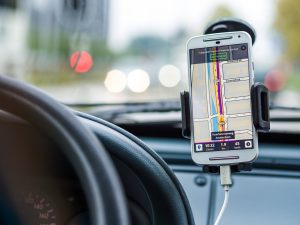Do you need a dedicated GPS tech on your car dash, or is a smartphone program smart enough to get you from A to B nowadays? Adding an excellent, renowned GPS navigation for your car, means you will be able to “reach your destination” without the pain of turning down side streets and dead-end roads.
A GPS navigation consists of:
- Global positioning system (or GPS) receiver that picks up satellite signals to pinpoint your precise location
- A screen displaying maps and route instructions
- Loudspeaker for verbal directions
- Map database, including points of interest such as schools, police stations, car parks, petrol stations and hospitals (most car navigation systems available in Australia use the identical mapping information, so the gap between versions is the way they allow you to use and display the information).
 GPS apps for smartphones
GPS apps for smartphones
If you are willing to invest $20 to $90, you can find an app on your phone which will work exactly like a car navigation device, together with security camera warning, trip planning and innovative lane advice. Most people know about Google Maps, which offers basic information on where you are and how to get from A to B. Android and iPhone users have access to the free Google Maps program, which shows your current location and provides voice management. Apple has also released their own version for iOS devices that is simply called Maps.
Most programs that use 3/4G connectivity, and gradually download parts of the map as you need them, to save space in your smartphone storage. Though handy, this puts you at the mercy of cellular networks that are prone to dropouts based upon your carrier and place. Drive off from an urban center and things may get spotty. Head into a tube and the cellular network may die completely.
Some allow you download an entire map over WiFi, so you can get around without worrying about your 3/4G connection. The drawback is that a nation or state map will occupy a sizable chunk of storage on your mobile phone. Plus, while just about all GPS programs support 3/4G, much fewer give you the choice to download maps to be used in offline mode. Additionally, if you plan to use the program often and for more than a couple of minutes, you’ll require a car charger, as GPS can quickly drain a phone’s battery.
It does not take long to get your head around GPS units and their program equivalents. All you will need to do is:
Type in where you need to go along with your device plots a path, calculates the traveling distance and estimated time of arrival, and displays the route on a map.
Portable or incorporated?
When needing a GPS system, multimedia installation in your car is the best way to go. Portable units sit in a cradle with a suction cap, which can be attached to the windscreen. They plug into the cigarette lighter, but also have a battery that offers a couple of hours of operation. They are installed within minutes, and can therefore easily be moved from car to car. Smartphones mount in precisely the identical way. Integrated systems are often connected into the car’s electronics, and may overcome some of the constraints of mobile units. By way of instance, they could use rate information to maintain calculating your position when there’s no satellite signal (like in a tube).
What to look for in an automobile navigation system
Data entry: Check how easy it is to enter addresses and routing preferences.
Screen: This ought to be big and glare-free, and reveal the information that you would like to see — like a two- or three-dimensional map view, distance to the next turn, present road name, time of birth, and distance to destination.
Setup and portability: Assess how easy the system is to attach, but also how easy it is to remove and carry or keep away.
